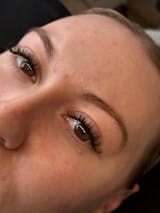Everything you need to know about Lash Glue
If you're a professional lash artist, you know that the right lash glue is crucial for creating stunning lash extensions that last. With so many options available on the market, it's essential to understand everything there is to know about lash glue. In this blog, we'll cover all the important information you need to make informed decisions when it comes to lash glue for professional use.
Types of Lash Glue
As a professional lash artist, you'll typically work with two main types of lash glue: cyanoacrylate-based glue and medical-grade adhesive.
-
Cyanoacrylate-Based Glue: Cyanoacrylate-based lash glues are the most commonly used adhesives for lash extensions. They are formulated with a fast-drying, strong bonding agent that creates a secure bond between the natural lashes and the lash extensions. Cyanoacrylate-based glues come in different viscosities, such as thin, medium, and thick, which affect the drying time and bonding strength of the glue. Thin glues have a faster drying time but may not be as strong, while thicker glues have a slower drying time but provide a stronger bond. It's important to choose the right viscosity based on your skill level and client's needs.
-
Medical-Grade Adhesive: Medical-grade adhesive is a more advanced type of lash glue that is ideal for clients with sensitive eyes or allergies. These glues are hypoallergenic and formulated with a lower concentration of cyanoacrylate, making them less likely to cause irritation or allergic reactions. Medical-grade adhesives are typically used by experienced lash artists who have clients with specific sensitivities.
Ingredients to Look For
When choosing a lash glue for professional use, it's important to look for certain ingredients that ensure a high-quality adhesive. Here are some key ingredients to consider:
-
Cyanoacrylate: Cyanoacrylate is the main ingredient in most lash glues and is responsible for creating the strong bond between the natural lashes and the lash extensions. Look for a lash glue that uses high-quality cyanoacrylate to ensure a reliable and durable bond.
-
Retention Agents: Some lash glues contain retention agents, such as polymeric additives or rubberized compounds, that help improve the bond's longevity. These agents can enhance the adhesive's resistance to heat, humidity, and oil, which can affect the retention of the lash extensions.
-
Formaldehyde-Free: Formaldehyde is a potentially harmful chemical that can cause skin irritation and allergic reactions. It's best to choose a lash glue that is formaldehyde-free to ensure the safety and comfort of your clients.
-
Latex-Free: Latex is another common allergen that can cause skin irritation and allergic reactions. Look for a lash glue that is latex-free to minimize the risk of allergic reactions in your clients.
-
Low Fume: Some lash glues can emit strong fumes that can be irritating to the eyes and respiratory system. Opt for a lash glue that has low fume emission to create a comfortable environment for both you and your clients during the application process.
Application Tips
The application process is a critical step in creating flawless lash extensions. Here are some essential tips to keep in mind when applying lash glue:
-
Prep the Lashes: Before applying lash glue, make sure to thoroughly clean and prime the natural lashes. Remove any traces of makeup, oils, or debris from the lashes using a gentle lash cleanser. Use a primer to neutralize the pH of the natural lashes, which can help improve the adhesive's bonding strength.
-
Use the Right Amount of Glue: It's crucial to use the right amount of lash glue to ensure a secure bond without any excess glue seeping onto the skin. Too much glue
Getting Your Glue Ready for a Client
- Insert nozzle pin before shaking glue (all glues by August Lashes come with a free nozzle pin)
- Shake the bottle side to side (not up and down), or use a glue shaker!
- Keep your bottle straight when squeezing out glue
- Squeeze our air & remaining glue onto an adhesive wipe to keep nozzle clear, so your nozzle remains perfect for next time
Help, my glue isn't working!
- Far and away, the most common problem when it comes to retention is picking the Glue Speed that suits you. Faster drying speeds aren't always better, especially if you're a methodical lash artist concentrating on perfect placement, Don't get rushed, sometimes slowing down will get you there faster!
- Check Glue Storage & Use by Date
- Make sure your glue lid is always tightly closed, otherwise oxygen can get to the glue, creating oxidisation, and ruining your glue
- Glue's need to be stored upright at a consistent temperature and humidity within the ranges specified by your glue supplier
- For optimal results, glues should only be used within one month of opening
- Humidity and temparature - most glue manufacturers recommend a room temperature of 24°C-28°C, with a humidity of 30%-70%. Aim to stay within these ranges to keep your glue working optimally
Try one of our August Lashes glues today here. We have a 100% product satisfaction guarantee, we stand by our products so much that if you're unhappy in any way after a quick use, we'll exchange, replace or refund, no questions asked!












